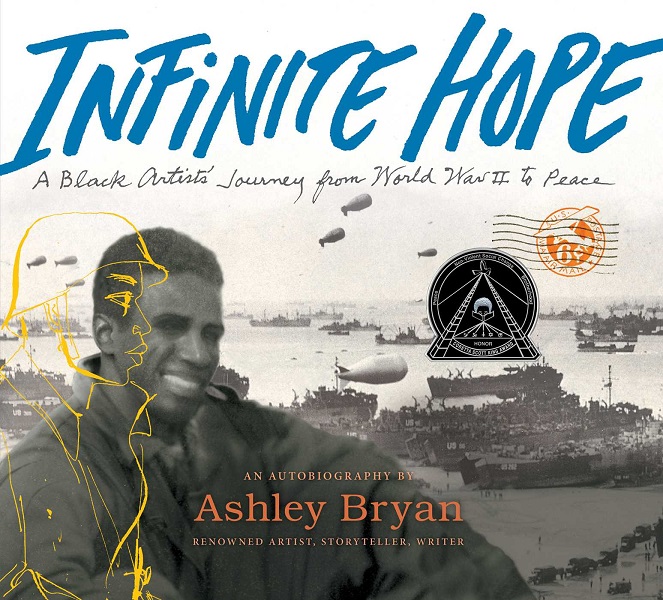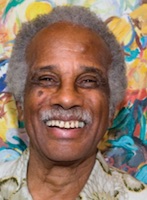Audiobook Excerpt narrated by Dion Graham
Infinite Hope: A Black Artist's Journey from World War II to Peace |
Audiobook excerpt narrated by Dion Graham.
Translate this transcript in the header View this transcript Dark mode on/off
Dion Graham: So they did not suspect the massive operation the allies were planning. They had not envisioned the invention of a Navy inspired vehicle called an amphibious duck, a vehicle that could operate as a truck on land and a boat on sea, with permitted the coast of Normandy to be chosen as a viable invasion spot. Still, the Nazis were extremely thorough and took few chances. They buried thousands of landmines throughout the Normandy coast, making it exceedingly dangerous to land.
They littered the shallows with barbed wire and they also built pillboxes, small concrete dug-in guard posts at intervals along the shore so that snipers could pick off infiltrators. Yet it was imperative to get the hundreds of allied cargo ships called Liberty ships, packed with soldiers and supplies onto the shore so they could begin making their way inland to help the French resistance fight the Nazis and free Paris.
The plan was massive. A flotilla of nearly 5,000 ships filled with almost 200,000 soldiers and hundreds more cargo ships carrying the enormous amount of supplies from bullets, to food, to medical provisions, the army would need his backing for a successful campaign, sailed to several French beachheads. There, they hovered off the French side of the English channel. My cargo ship led anchor off the Normandy beach, we codenamed Omaha.
At this point, we all knew we were planning an invasion, but we didn't know when it would actually happen. We were eager and anxious for the actual invasion to begin so we could unload all the cargo for the advancing allies. A key part of the allies plan had to do with the weather. It was storming with seas so heavy and winds so high that the Nazis never imagined that anyone would attempt to land in such conditions.
That, combined with the belief that the beaches were impenetrable and thus impossible to breach, led their high commander Field Marshall Erwin Rommel to make a critical decision. He left France for Germany to visit his family for his wife's birthday and to meet with Adolf Hitler. Several other commanders took a break as well, leaving the beach unsupervised. Rommel hadn't expected a break in the weather. He hadn't expected the tenacity of the allied forces. But the allies were keeping a keen eye on the weather.
And sure enough, on the morning of June 6th, 1944, the winds died down. The seas calmed and the high tide and the command from general Dwight D. Eisenhower, well, what we needed to gain that most strategic of positions. Operation overlord was to begin. We were soon just a few hundred yards from the beaches. A ship Eva, the clean, straight line of above, leaping clear of the water, a ship to be loaded, unloaded for 1944, today, by us. The soldiers are working, sweating, looking at the boxes they are unloading and stacking, labeled from the United States of America, one of the United Nations. They are praying for victory in 1944, actually.
Omaha beach, the beach my battalion was to invade, was the most heavily defended of all the beaches. The very first thing that had to be done once we reached shore was to try to get the men safely across into the mainland. This meant we had to clear the beach of the thousands of landmines lying in wait. This extremely dangerous task was left primarily to the black quartermaster companies, and it had to be completed before the infantry could storm the beach.
Black soldiers were ordered to use their mess forks to probe sand for anti-personnel bombs. Many black lives were lost when mines exploded as they were being cleared. Well, the mines were so well buried that they were accidentally stepped on and detonated.
The merchant supply ships waited offshore until it was safe enough to follow up with reinforcements. Even after the beaches were swept, nearly the entire first wave of soldiers storming off the ships was lost to drowning, mines that couldn't be detected or to pillbox sniper fire. It was when you saw bodies floating in the water that you truly understood what was happening. All told, more than 3,600 allied soldiers, many of them black, were lost on that first day on Omaha and Utah beach.
The fallen soldiers were buried in temporary mass graves and it was again the black quartermaster soldiers who were assigned to this grim task. There was always a great hurry to clear the beaches so that the newly disembarking soldiers wouldn't have to see the devastation.
This audio excerpt is provided by Simon & Schuster Audio.



